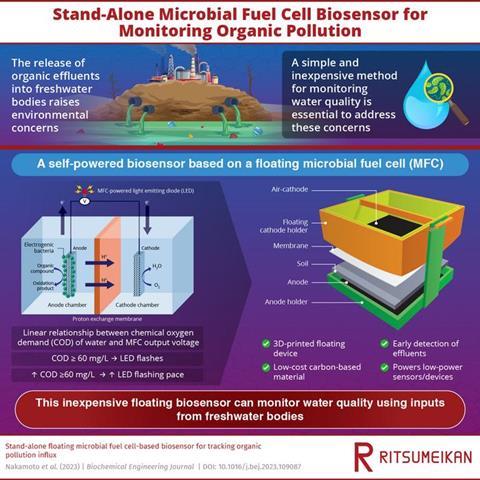The discharge of organic effluents - biodegradable waste materials from plants and animals - into freshwater bodies is a significant environmental concern, affecting the health and sustainability of these aquatic ecosystems. However, the methods currently available for inspecting water quality are complex and costly.

Researchers from Ritsumeikan University, Japan, have recently developed a self-powered, inexpensive, and floating biosensor for monitoring water quality at the input of freshwater lakes and rivers. This paper was published in the Biochemical Engineering Journal.
“We developed a self-powered, stand-alone, floating biosensor based on a microbial fuel cell (MFC) for early organic wastewater detection. The MFC case was fabricated by a 3D printer and the electrodes were fabricated from low-cost carbon-based materials,” says Professor Kozo Taguchi from the College of Science and Engineering, Department of Electrical and Electronic Engineering, Ritsumeikan University, who led the study.
Electrogenic bacteria
MFCs generate electricity with the help of electrogenic bacteria. These microorganisms produce an electric current as a result of their biological metabolism. The amount of electricity generated by the MFC is proportional to the concentration of the organic waste that is being consumed by the electrogenic microorganisms. This characteristic feature is used to design organic waste biosensors powered by MFCs.
Using inexpensive carbon-based materials, the Japanese research team developed a self-powered biosensor based on a floating MFC (FMFC) to continually track the level of organic contamination in lakes and rivers. To this end, the team filled the anode (the electrode where oxidation occurs and electrons are given off) of the FMFC with soil containing electrogenic bacteria. The anodic bacteria subsequently decomposed the organic matter present in the water and converted the stored chemical energy into electricity. The electrical output was then used as a measure of the organic waste present in the contaminated water.
PROMOTED: AMI has teamed up with QIAGEN to help you get the highest yields from your DNA Extractions. Get your free guide here.
Although the researchers did not characterize the bacterial communities present in the soil sample, they rationally hypothesized that microorganisms from the genera Geobacter, Shewanella, and Pseudomonas contributed to the electrical activity. Prior studies indicate that paddy soils naturally contain electrogenic bacteria belonging to these genera.
Harnessing the electricity
Next, the team added a light-emitting diode (LED) to the floatable biosensor assembly. The LED was able to harness the electricity produced by the electrogenic bacteria and visually indicate the level of organic contamination in the water samples under investigation.
It started flashing when the chemical oxygen demand (COD)—a parameter used to measure the level of organic contaminants in water—exceeded the threshold value of 60 mg/L. In addition, the LED flashed at an increased pace when the COD significantly exceeded the threshold value.
Prof. Taguchi adds: “Because the FMFC biosensor produces its own electricity, it requires no external power supply. Moreover, it can be used in early detection systems that monitor influxes of organic wastewater in freshwater bodies.”
Mr. Trang Nakamoto and Mr. Dung Nakamoto, both from the College of Science and Engineering, contributed to the biosensor development.
In summary, the study authors designed, developed, and tested a 3D-printed and cost-effective FMFC biosensor that effectively monitors organic contamination in freshwater bodies.
Topics
- Asia & Oceania
- Bacteria
- biosensor
- Clean Water
- Dung Nakamoto
- Economic Equality
- electrogenic bacteria
- Future Technologies
- Future Technologies
- Geobacter
- Kozo Taguchi
- Pseudomonas
- Ritsumeikan University
- Sample preparation, filtration, detection and treatment techniques for water-borne pathogens
- Shewanella
- Trang Nakamoto
- World Soil Day




No comments yet